The Arrival of the Bees
Last night was our re-rescheduled pickup for the 3 lb. package of Italian honeybees that we ordered back at the start of winter, when the thought of needing 60,000 fuzzy insects to pollinate the abundance of flowering fruit, vegetable, herb, and ornamental plants that grace our land seemed an unspeakable hope. The bees were coming up from Georgia; in Virginia, they'd be picked up by the beekeeper in Frederick from whom we'd purchased them, and we'd in turn pick them up in Frederick. After weeks of disappointment, Bobby received an email Thursday--the delivery was on, and we could start showing up to pick up our bees at 4 PM!
Northern Virginia and DC traffic being what it is, Bobby received an email late yesterday afternoon that pickup had been bumped back again to 8 PM. We went out to dinner in Westminster and planned to take 27 down to 70 and, from there, out to Frederick after dinner, but by the time we were finished eating, pickup time had been delayed again to 10. We rolled with it; we went to Goodwill, where I spent too much on books, and then had frozen mochas at Panera. I got up to go to the bathroom and, when I returned, the pickup time had been pushed back yet again to 10:20.
We headed out anyway, our directions dictated by Bobby and copied by me on the back of our receipt. I wanted to see my favorite summer and autumn stars--Cassiopea, Capella, Orion--but the western sky was still clotted with clouds from the evening's thunderstorms. Nonetheless, it was a gorgeous evening; we rode with the windows down and the new Fleet Foxes album playing.
On an orange-lit street in Frederick, having arrived early, we awaited the arrival of our bees. A man was there before us, waiting with arms crossed on the front porch of the slightly tattered rowhouse owned by the beekeeper who was, as we waited, bringing our first colony to us. A fireworks display thundered in the distance at the baseball stadium. The streets were still alive, though sluggishly winding toward sleep: a man dragging a suitcase on wheels and bobbling numerous shopping bags--a cell phone pinned between his shoulder and his ear--let himself into a house. Toughs sporting bandanas swaggered in pairs or threes down the sidewalk and out of sight. The fireworks stopped; the street came to rest. Bobby and I talked, and laughed, loud. More people arrived for the bees, the sort of people I have come to identify as beekeeper types: stout-necked men with crewcuts, wearing long-sleeved T-shirts. Bobby's ponytail and my femaleness were out of place. A few women hovered at the clump of beekeepers, at the elbows of the men with whom they'd come.
On the quiet street, the pickup truck and trailer announced itself before it came into sight. As it swung around the block, I caught sight of dozens of wood-and-wire bee packages stacked on the swaying trailer. Those of us there for pickup had taken all of the street parking; the truck stopped in the middle of the street, trusting the late hour, and the amber emergency flashers pulsed as we lined up for our bees. I inched closer to the trailer to see them: wire mesh cages enclosing a dark mass. Some of the packages had bees clinging to the outside as well; I wondered what we'd do if we got one of them. I hoped we didn't: neither loose bees in the car or abandonment of the stragglers appealed to me. Some of the packages had squashed bees on them.
Then a package was placed in my hands, humming with the gentle under-sound of 10,000 homeless bees huddled around the syrup jar that fed them, and their queen. We were safe in the car before I realized that we had two of our own stragglers, but I didn't need to worry about them flying loose; they clung to their sisters through the mesh cage, unmoving.
The western sky was clear but Cassiopea and Capella had long since dipped beneath the horizon; it was after 11. Hoots and Hellmouth were on the sound system now: "Abattoir Altar Boy and Girl," appropriately enough:
Sugarbabe, Honeybee
Jelly Roll, My Sweetpea
Other names, they guess at who you be
So just taste and see it is good
Taste and see it is good
We couldn't install the bees at night, so I carried them carefully to spend the night in the shed--not the one with the chickens in it! That night, I dreamt that I found another package of bees that I'd ordered and forgotten; they'd all died. Although I stayed up late, I was awake at 7:30, listening to Bobby moving around and waiting for him to tell me it was time.
Some psychologists have theorized that certain phobias show up with greater-than-expected frequency because, in a bygone era requiring survival in the raw wilderness, those fears gave the afflicted an evolutionary advantage. Hence, although guns and cars kill far more people than nearly anything else in modern society, we fear snakes and spiders. And bees. Bobby has been working on his anxiety around flying insects, but we've never kidded ourselves that, at least to start, I would be the primary caretaker of the bees. I'd never had the good sense to develop a fear of most natural things, save a brief stint of arachnophobia after a traumatic experience at Girl Scout camp and a long-standing fascinated dread of tornadoes. I used to catch bees in my butterfly net and pet the bumblebees feeding on my mother's flowers. Since knowing the bees were coming, I almost craved the soft feel of their feet on my hands. Some foraging honeybees had been visiting our patio; I would sit still and let them brush my legs and face and breathe, without fear.
I was tempted to wear just the veil, but better sense prevailed: If I ended up in a situation I didn't like, I didn't want Bobby stuck with having to handle the bees by himself, so I donned the full suit. No gloves, though. I wanted that minimal contact with my bees, at least.
Package bees come in a wire-and-wood cage with a can of sugar syrup suspended in the middle.

The queen is in her own separate small cage at the top of the package with her own little retinue of nurse bees. The queens and workers that come with package bees are raised separately, so the workers need time to get used to the queen; if they find a foreign queen in their midst, they'll often kill her.
Although bee swarms are an intimidating sight, bees are never less dangerous than when they're in a swarm. Bees naturally swarm when the colony becomes too crowded: The workers raise a second queen and, after she emerges and mates, half of the hive takes off with her for more spacious accommodations. Package bees are in a similar frame of mind. Without a hive to call home, without brood and honey to defend, they become docile, complacent.
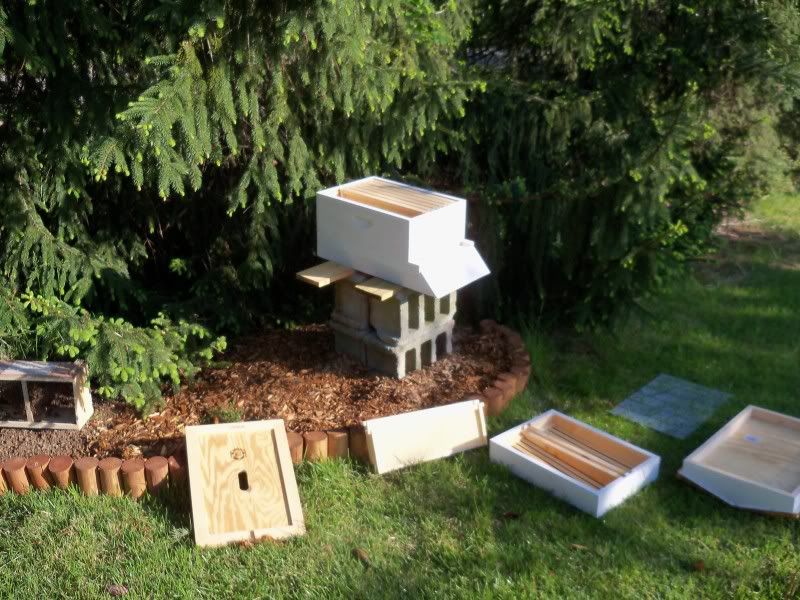
[The disassembled hive, from left to right, with the hive structure in the rear: the package of bees, inner cover, two frames, hive-top feeder, queen excluder, and outer cover.]
Thankfully, this makes installing a package of bees scarier in theory than in actuality. First, Bobby sprayed them down thoroughly with a 1:1 sugar-water solution. This keeps them busy, cleaning themselves and each other, and makes it difficult for them to fly so they literally pour out of the package when the time comes.
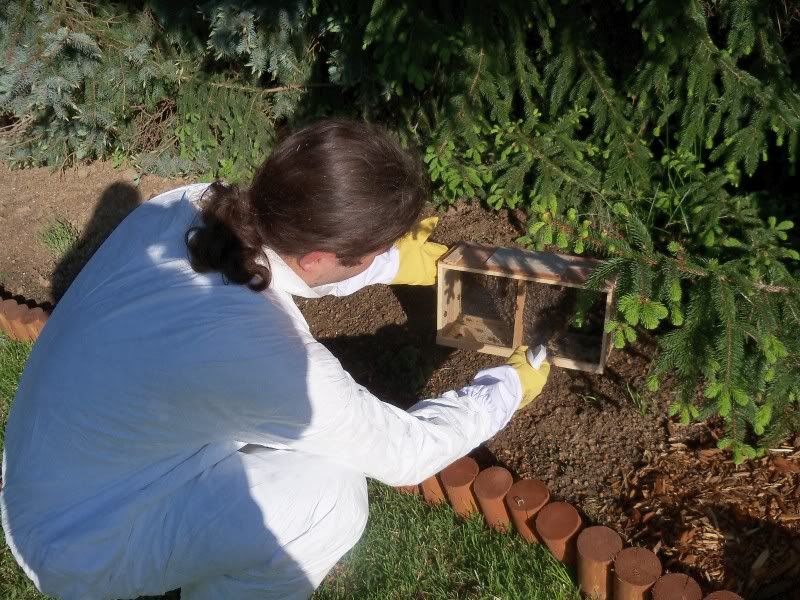
The next step is removing the package cover and, then, the jar of sugar syrup at the center. This was the most anxiety-provoking moment for me; I am notoriously clumsy at all things mechanical, which includes using hand tools, and I worried that I was going to drop the syrup into the package rather than being able to extract it.

Luckily, it came out after a few tries, and the package was open. Our one casualty occurred here: As I drew the syrup from the package, a bee became caught between the two and was crushed.

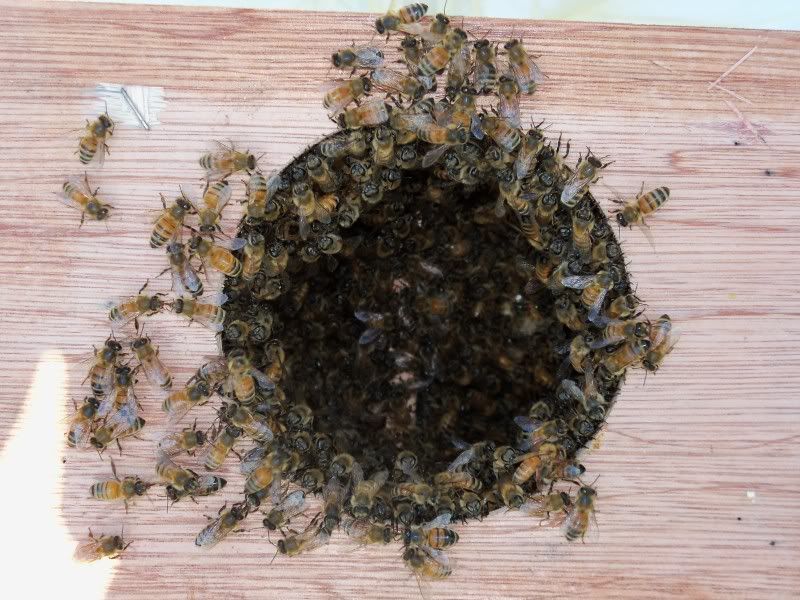
Next is removing and inspecting the queen. Her cage is stapled to the top of the package, and when I removed the staple, she dropped right into the heart of the swarm of bees. I reached in and plucked her out before I had a chance to think about it. Bobby said later that that was "balls deep"!
She is larger than the worker bees. You can't see her in here, unfortunately, but you can see her cage.
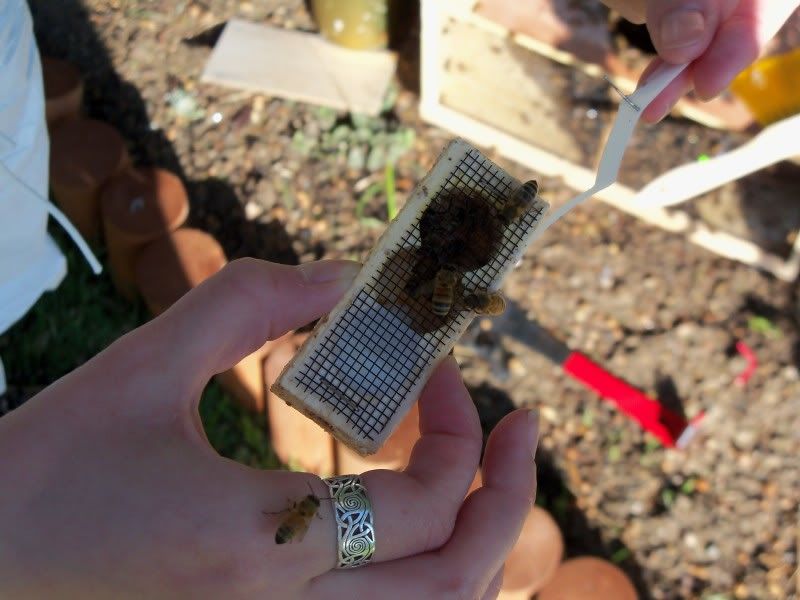
The white material on the left-hand side of the queen cage is a candy plug: The nurse bees in with her will slowly eat their way out; by then, in theory, the colony is used to her and will accept her as their queen, and she will start laying. The queen cage goes in first, underneath two of the middle frames.
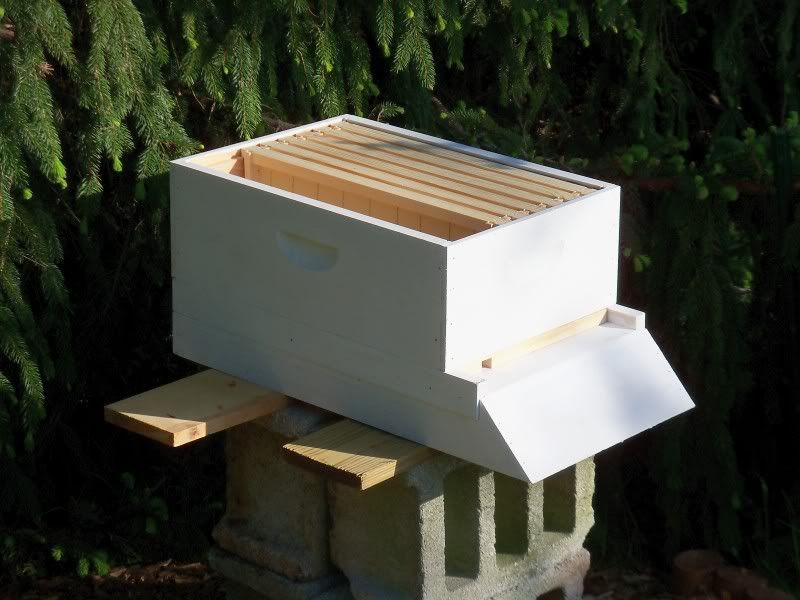
Until fairly recent history, beekeepers kept their colonies in skeps: those coiled, iconic beehives constructed of wicker and covered with a mixture of mud and manure. The problem with skeps was that, in order to extract the honey, the colony had to be killed, as there was no way to remove the comb without destroying the hive. In 1851, Lorenzo Langstroth invented the concept of "bee space" and, with it, the removable frame. Each of the blond-wood stripes is a frame, on which the bees construct honeycomb, where they raise larvae and store honey. Because you can remove the frames, you can check the hive and harvest the honey without killing the colony.
With the queen in place, the next step is to give the bee package a couple of good thumps on the ground, then dump them in.
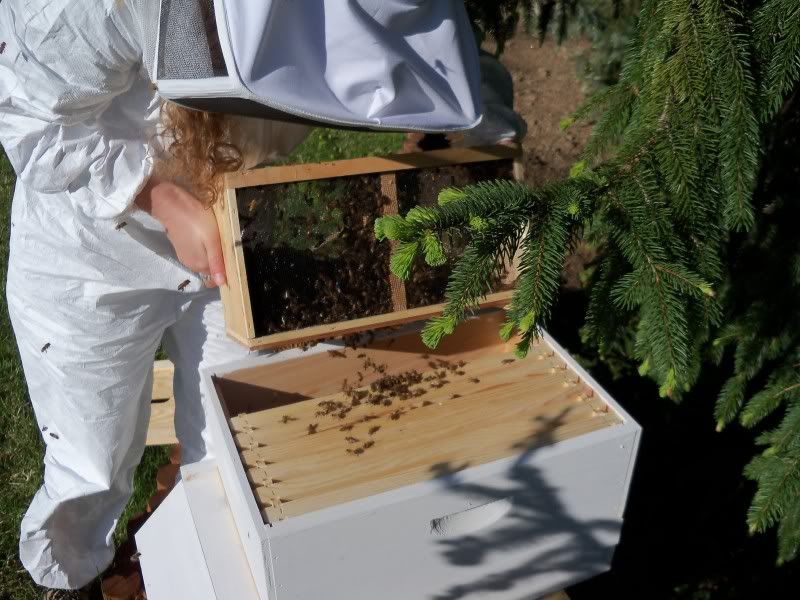
They tumble into the bottom of the hive, where they dazedly mill over each other.
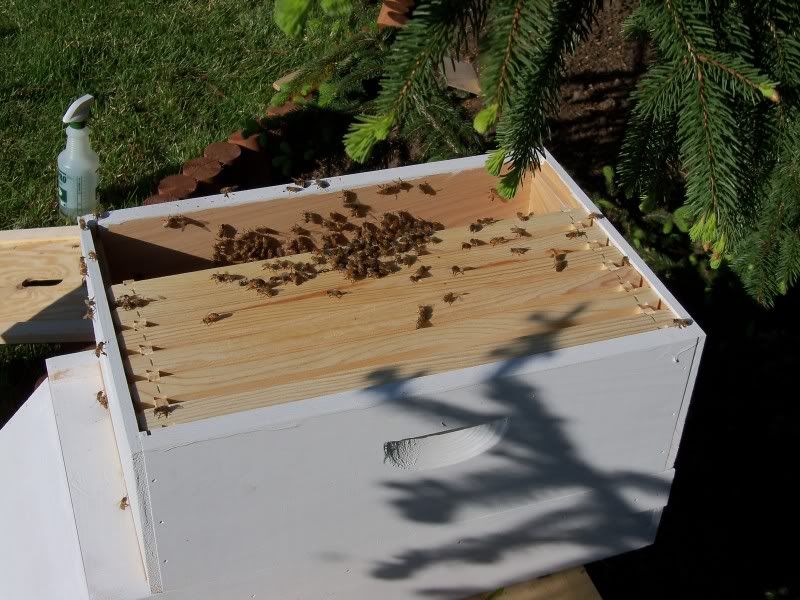

Next, you gently set the two removed frames back into place. The mass of bees slides to the side when it feels the frames rest on top of them, and the frames sink into place.
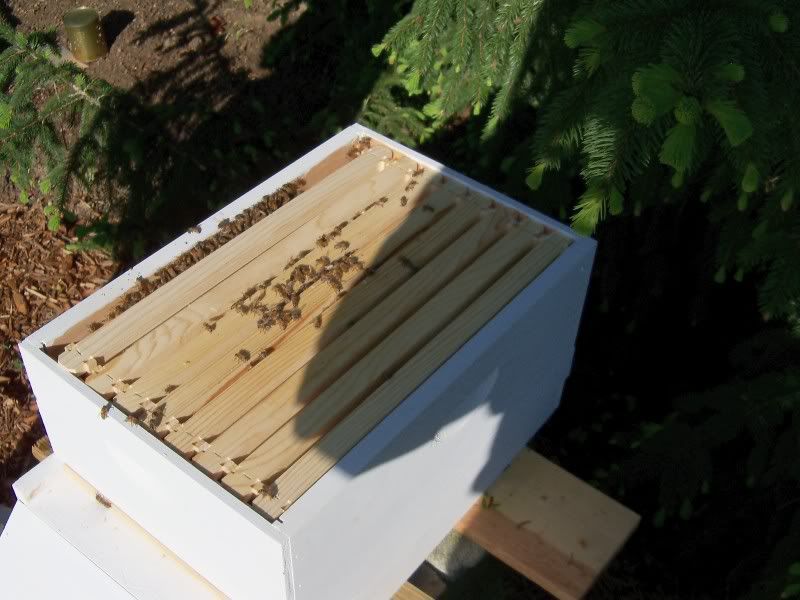
By this point, the air is full of swooping, confused bees. You stop feeling them land on you after a while; you are part of their landscape, and they use your hand or shoulder to clean their wings or survey their new environment. Adjust the frames, brush the stragglers into the hive, fill the feeder, do everything carefully so that you don't crush the one just emerging, buzzing her sticky wings.
Then they're in and everything's done! Within two hours, the stragglers that hung behind in the cage had taken their sisters' lead and entered the hive; the cage sits empty beneath the hive.
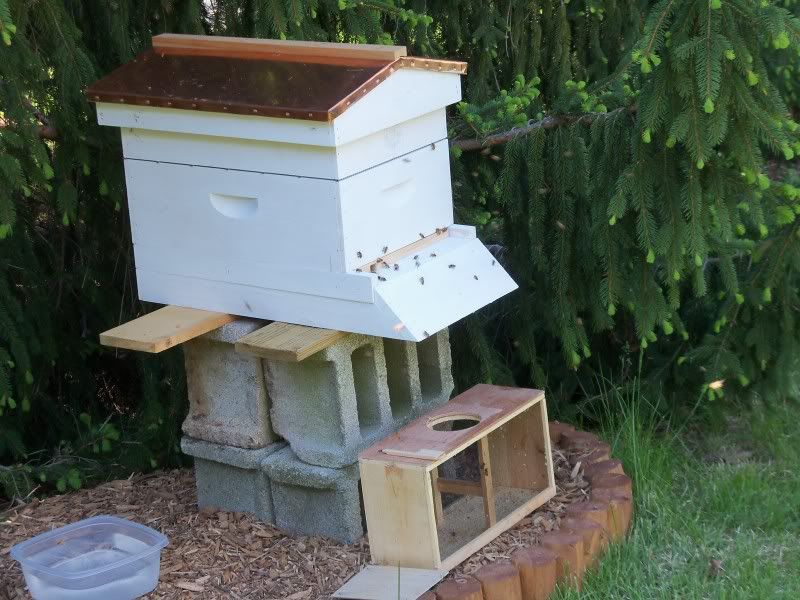
This was taken two hours ago: They are busy at the entrance and, every now and then, one swings about and shoots off into the air, off to explore. Most of them gently orbit the hive. Approach the hive and someone always comes over and buzzes just a few inches away, investigating, before returning to her sisters.
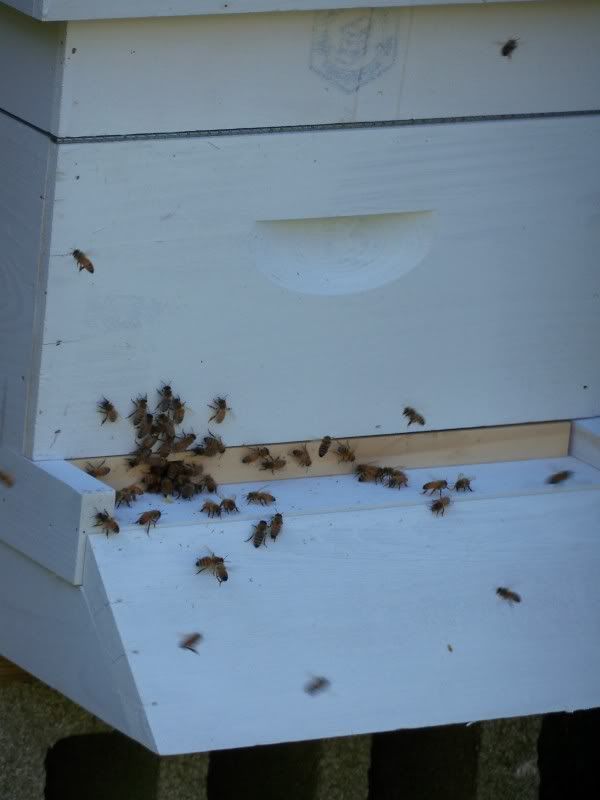
My bees are here! It is terribly tempting to look inside, see what they're up to, but we learned at beekeeper's class that even brief visits can set them back a full day in their work. In a few days, we'll check the queen to make sure she's out and starting to lay; until then, I'll have to be content to watch them from outside the hive.
In the 19th century, farmers used to tell the bees when news--good or bad--came to their families. I told my bees, "I love you! I'm so glad you're here!"
This post was originally posted on Dreamwidth and, using my Felagundish Elf magic, crossposted to LiveJournal. You can comment here or there!
http://dawn-felagund.dreamwidth.org/268185.html
Northern Virginia and DC traffic being what it is, Bobby received an email late yesterday afternoon that pickup had been bumped back again to 8 PM. We went out to dinner in Westminster and planned to take 27 down to 70 and, from there, out to Frederick after dinner, but by the time we were finished eating, pickup time had been delayed again to 10. We rolled with it; we went to Goodwill, where I spent too much on books, and then had frozen mochas at Panera. I got up to go to the bathroom and, when I returned, the pickup time had been pushed back yet again to 10:20.
We headed out anyway, our directions dictated by Bobby and copied by me on the back of our receipt. I wanted to see my favorite summer and autumn stars--Cassiopea, Capella, Orion--but the western sky was still clotted with clouds from the evening's thunderstorms. Nonetheless, it was a gorgeous evening; we rode with the windows down and the new Fleet Foxes album playing.
On an orange-lit street in Frederick, having arrived early, we awaited the arrival of our bees. A man was there before us, waiting with arms crossed on the front porch of the slightly tattered rowhouse owned by the beekeeper who was, as we waited, bringing our first colony to us. A fireworks display thundered in the distance at the baseball stadium. The streets were still alive, though sluggishly winding toward sleep: a man dragging a suitcase on wheels and bobbling numerous shopping bags--a cell phone pinned between his shoulder and his ear--let himself into a house. Toughs sporting bandanas swaggered in pairs or threes down the sidewalk and out of sight. The fireworks stopped; the street came to rest. Bobby and I talked, and laughed, loud. More people arrived for the bees, the sort of people I have come to identify as beekeeper types: stout-necked men with crewcuts, wearing long-sleeved T-shirts. Bobby's ponytail and my femaleness were out of place. A few women hovered at the clump of beekeepers, at the elbows of the men with whom they'd come.
On the quiet street, the pickup truck and trailer announced itself before it came into sight. As it swung around the block, I caught sight of dozens of wood-and-wire bee packages stacked on the swaying trailer. Those of us there for pickup had taken all of the street parking; the truck stopped in the middle of the street, trusting the late hour, and the amber emergency flashers pulsed as we lined up for our bees. I inched closer to the trailer to see them: wire mesh cages enclosing a dark mass. Some of the packages had bees clinging to the outside as well; I wondered what we'd do if we got one of them. I hoped we didn't: neither loose bees in the car or abandonment of the stragglers appealed to me. Some of the packages had squashed bees on them.
Then a package was placed in my hands, humming with the gentle under-sound of 10,000 homeless bees huddled around the syrup jar that fed them, and their queen. We were safe in the car before I realized that we had two of our own stragglers, but I didn't need to worry about them flying loose; they clung to their sisters through the mesh cage, unmoving.
The western sky was clear but Cassiopea and Capella had long since dipped beneath the horizon; it was after 11. Hoots and Hellmouth were on the sound system now: "Abattoir Altar Boy and Girl," appropriately enough:
Sugarbabe, Honeybee
Jelly Roll, My Sweetpea
Other names, they guess at who you be
So just taste and see it is good
Taste and see it is good
We couldn't install the bees at night, so I carried them carefully to spend the night in the shed--not the one with the chickens in it! That night, I dreamt that I found another package of bees that I'd ordered and forgotten; they'd all died. Although I stayed up late, I was awake at 7:30, listening to Bobby moving around and waiting for him to tell me it was time.
Some psychologists have theorized that certain phobias show up with greater-than-expected frequency because, in a bygone era requiring survival in the raw wilderness, those fears gave the afflicted an evolutionary advantage. Hence, although guns and cars kill far more people than nearly anything else in modern society, we fear snakes and spiders. And bees. Bobby has been working on his anxiety around flying insects, but we've never kidded ourselves that, at least to start, I would be the primary caretaker of the bees. I'd never had the good sense to develop a fear of most natural things, save a brief stint of arachnophobia after a traumatic experience at Girl Scout camp and a long-standing fascinated dread of tornadoes. I used to catch bees in my butterfly net and pet the bumblebees feeding on my mother's flowers. Since knowing the bees were coming, I almost craved the soft feel of their feet on my hands. Some foraging honeybees had been visiting our patio; I would sit still and let them brush my legs and face and breathe, without fear.
I was tempted to wear just the veil, but better sense prevailed: If I ended up in a situation I didn't like, I didn't want Bobby stuck with having to handle the bees by himself, so I donned the full suit. No gloves, though. I wanted that minimal contact with my bees, at least.
Package bees come in a wire-and-wood cage with a can of sugar syrup suspended in the middle.

The queen is in her own separate small cage at the top of the package with her own little retinue of nurse bees. The queens and workers that come with package bees are raised separately, so the workers need time to get used to the queen; if they find a foreign queen in their midst, they'll often kill her.
Although bee swarms are an intimidating sight, bees are never less dangerous than when they're in a swarm. Bees naturally swarm when the colony becomes too crowded: The workers raise a second queen and, after she emerges and mates, half of the hive takes off with her for more spacious accommodations. Package bees are in a similar frame of mind. Without a hive to call home, without brood and honey to defend, they become docile, complacent.

[The disassembled hive, from left to right, with the hive structure in the rear: the package of bees, inner cover, two frames, hive-top feeder, queen excluder, and outer cover.]
Thankfully, this makes installing a package of bees scarier in theory than in actuality. First, Bobby sprayed them down thoroughly with a 1:1 sugar-water solution. This keeps them busy, cleaning themselves and each other, and makes it difficult for them to fly so they literally pour out of the package when the time comes.

The next step is removing the package cover and, then, the jar of sugar syrup at the center. This was the most anxiety-provoking moment for me; I am notoriously clumsy at all things mechanical, which includes using hand tools, and I worried that I was going to drop the syrup into the package rather than being able to extract it.

Luckily, it came out after a few tries, and the package was open. Our one casualty occurred here: As I drew the syrup from the package, a bee became caught between the two and was crushed.


Next is removing and inspecting the queen. Her cage is stapled to the top of the package, and when I removed the staple, she dropped right into the heart of the swarm of bees. I reached in and plucked her out before I had a chance to think about it. Bobby said later that that was "balls deep"!
She is larger than the worker bees. You can't see her in here, unfortunately, but you can see her cage.

The white material on the left-hand side of the queen cage is a candy plug: The nurse bees in with her will slowly eat their way out; by then, in theory, the colony is used to her and will accept her as their queen, and she will start laying. The queen cage goes in first, underneath two of the middle frames.

Until fairly recent history, beekeepers kept their colonies in skeps: those coiled, iconic beehives constructed of wicker and covered with a mixture of mud and manure. The problem with skeps was that, in order to extract the honey, the colony had to be killed, as there was no way to remove the comb without destroying the hive. In 1851, Lorenzo Langstroth invented the concept of "bee space" and, with it, the removable frame. Each of the blond-wood stripes is a frame, on which the bees construct honeycomb, where they raise larvae and store honey. Because you can remove the frames, you can check the hive and harvest the honey without killing the colony.
With the queen in place, the next step is to give the bee package a couple of good thumps on the ground, then dump them in.

They tumble into the bottom of the hive, where they dazedly mill over each other.


Next, you gently set the two removed frames back into place. The mass of bees slides to the side when it feels the frames rest on top of them, and the frames sink into place.

By this point, the air is full of swooping, confused bees. You stop feeling them land on you after a while; you are part of their landscape, and they use your hand or shoulder to clean their wings or survey their new environment. Adjust the frames, brush the stragglers into the hive, fill the feeder, do everything carefully so that you don't crush the one just emerging, buzzing her sticky wings.
Then they're in and everything's done! Within two hours, the stragglers that hung behind in the cage had taken their sisters' lead and entered the hive; the cage sits empty beneath the hive.

This was taken two hours ago: They are busy at the entrance and, every now and then, one swings about and shoots off into the air, off to explore. Most of them gently orbit the hive. Approach the hive and someone always comes over and buzzes just a few inches away, investigating, before returning to her sisters.

My bees are here! It is terribly tempting to look inside, see what they're up to, but we learned at beekeeper's class that even brief visits can set them back a full day in their work. In a few days, we'll check the queen to make sure she's out and starting to lay; until then, I'll have to be content to watch them from outside the hive.
In the 19th century, farmers used to tell the bees when news--good or bad--came to their families. I told my bees, "I love you! I'm so glad you're here!"
This post was originally posted on Dreamwidth and, using my Felagundish Elf magic, crossposted to LiveJournal. You can comment here or there!
http://dawn-felagund.dreamwidth.org/268185.html